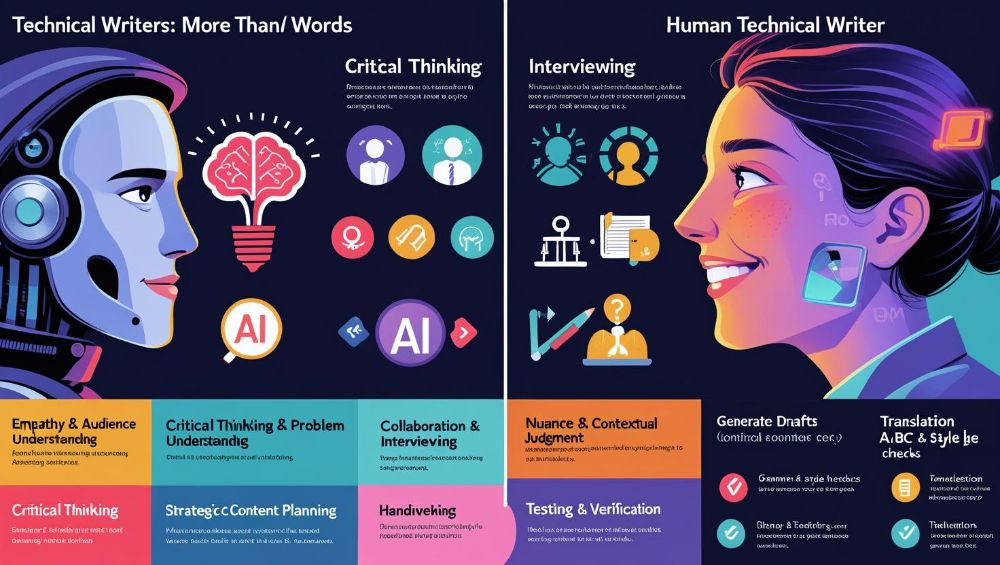Why AI won't replace content and technical writing and how to thrive
Okay, let's tackle the question of AI and the future of technical and content writing. It's a hot topic, and it's understandable to feel a mix of curiosity and concern. As someone working in the field, especially with no-code tools and tutorials, I understand both the power of technology and the irreplaceable value of clear, human communication.
The buzz around AI feels inescapable. Every day, a new tool is promising to automate tasks that once seemed exclusively human. For those of us in technical writing, content creation, and especially no-code documentation, this raises a crucial question:
What does this mean for my role?
Will AI eventually take over writing tutorials, documentation, and video scripts?
The simple answer is no. Well, not entirely.
While AI is a powerful tool that will undoubtedly change how we work, it won't replace the fundamental skills and human judgment that define a truly effective writer. The "AI frenzy" emphasises AI's capabilities, but often overlooks its significant limitations when it comes to complex, nuanced communication.

Does AI really have all the qualities?
Think about the last truly excellent piece of documentation or tutorial you read. It didn't just present information; it guided you, anticipated your questions, and felt like it understood your struggle. This is where human insight shines.
Technical writing isn't just about stringing words together; it's about understanding a complex system and translating it for a specific audience with varying levels of technical knowledge and different goals.
A writer can sit in a meeting with engineers and product managers, pick up on subtle cues about why a feature was built a certain way, understand the intended user workflow (and where users might get stuck), and ask clarifying questions that haven't been explicitly programmed. They can empathise with the frustrated user trying to figure out a difficult setup process late at night. They can structure information not just logically from a system perspective, but from a user's learning path perspective. This involves critical thinking, strategic planning, and a deep understanding of human behaviour and learning, qualities AI currently lacks.
Consider a scenario: documenting a complex troubleshooting process for a no-code platform integration. AI might be able to pull data from forums or internal notes, but it wouldn't necessarily grasp the common user misconceptions or the specific pain points users experience in real-world scenarios. A writer, through testing, user feedback, and collaboration, understands these nuances and structures the guide to preempt those issues, adding helpful tips and alternative approaches based on real-world problem-solving, not just programmed logic.
This ability to synthesise disparate information sources, apply critical judgment, and tailor content with genuine empathy is beyond current AI capabilities.
This demonstrates why human insight is irreplaceable in creating documentation that truly serves its purpose.
Areas where AI could automate or assist
It's important to be realistic about AI's strengths. There are certainly aspects of technical and content writing that AI is well-suited to handle, potentially automating tasks that are repetitive or require processing large amounts of text quickly.
These areas include:
- Generating first drafts for routine content: Think simple API endpoints with consistent structures, or basic product descriptions based on structured data. AI can provide a starting point, freeing up the writer for more complex work.
- Summarising long documents or meetings: Need a quick overview of a technical spec or a recorded meeting? AI can often pull out key points efficiently.
- Grammar, style, and basic proofreading: AI tools are becoming increasingly sophisticated at identifying errors and suggesting stylistic improvements.
- Translating existing content: While accuracy varies, AI can provide initial translations that a human editor can then refine.
- Generating content outlines or brainstorming ideas: AI can quickly generate potential structures or topic lists based on keywords or descriptions.
- Answering simple, direct questions based on existing documentation: Chatbots powered by LLMs are already being used to provide quick answers from knowledge bases.
Think of AI here as a powerful assistant. It can handle the grunt work, the first pass, the organisational tasks, but it needs human oversight, correction, and refinement to produce accurate, clear, and truly helpful content.
Using AI as your advantage
Instead of fearing AI, embrace it as a tool to enhance your productivity and the quality of your work.
The future isn't about human writers versus AI; it's about human writers who skillfully leverage AI.
This is how you can leverage AI to enhance your technical writing skills without losing your unique voice. Your unique voice comes through in your choice of words, your analogies, your tone, and your understanding of the audience – elements you add during the editing and refinement stages.
Here's how you can use AI to your advantage:
- Accelerate drafting: Use AI to generate initial outlines or rough drafts from your notes or source material. You then take this draft and apply your understanding, structure, and voice.
- Overcome writer's block: If you're stuck on how to phrase a complex concept, ask AI for alternative explanations or analogies.
- Research support: Tools like Perplexity can provide concise summaries of technical topics or explain concepts you're unfamiliar with, speeding up your research phase.
- Refine language: Use AI to check for clarity, conciseness, or to rephrase sentences for a different reading level or tone.
- Generate examples: If you need code snippets or examples for a tutorial, AI can often generate plausible ones (though always verify their accuracy!).
- Summarise and synthesise: Feed AI interview transcripts or technical specifications and ask for summaries of key decisions or features to document.
AI tools worth exploring include:
- Claude: Known for its ability to handle longer texts and its helpful, less opinionated responses. Good for summarising and drafting longer pieces.
- Perplexity AI: Excellent for research, providing sourced answers to technical questions. Think of it as a search engine combined with an AI summary tool.
- Deepseek Coder / LLAMA (various models): Useful if you're documenting code or need code examples. Ensure you use recent, capable models and always verify the code.
- Other general LLMs (like ChatGPT, Gemini): Versatile for brainstorming, rephrasing, and generating different types of text.
Remember, AI provides a starting point. You are the editor, the fact-checker, the strategist, and the human voice that ensures the content is accurate, relevant, and truly helpful to a human user.
Skills to develop to stay valuable
As the landscape evolves, certain skills become even more critical for technical and content writers. To stay valuable as an AI-assisted technical writer, focus on developing competencies that complement and elevate AI's capabilities.
These are skills that AI cannot easily replicate:
- Critical thinking and verification: AI can "hallucinate" or present incorrect information convincingly. Your ability to fact-check, question assumptions, and verify AI-generated content against reliable sources (SMEs, testing, official documentation) is paramount.
- Information architecture and content strategy: Knowing how to structure large bodies of information (a knowledge base, a documentation site) so users can find what they need intuitively. Understanding how individual pieces of content fit into the larger user journey and business goals.
- Audience analysis and empathy: Deeply understanding your target audience's needs, pain points, technical level, and goals. Tailoring content tone, depth, and format specifically for them.
- Subject matter expertise (or the ability to acquire it): Becoming proficient enough in the technology or domain you write about to understand its nuances and speak credibly with SMEs.
- Interviewing and collaboration skills: Effectively extracting information from busy subject matter experts, asking probing questions, and collaborating across teams (product, engineering, support, UX).
- User experience (UX) principles: Understanding how users interact with documentation and how to design content experiences that are intuitive and effective, just like good software design.
- Prompt engineering: Learning how to craft effective prompts for AI tools to get the best possible output. This is a new and evolving skill.
- Understanding AI's limitations and ethics: Knowing what AI can and cannot do, and being mindful of potential biases or inaccuracies in AI-generated content.
Focusing on these higher-order skills positions you as a strategic content expert, not just a word processor.
Proving your value and advancing in the AI era
So, how do you prove your skills are still valuable despite the AI rage, and how do you advance? By demonstrating impact and showcasing your unique human capabilities, often enhanced by AI.
-
Showcase results: Quantify the impact of your work whenever possible. Share examples where your documentation solved a unique user problem, clarified ambiguous requirements, or prevented misunderstandings that AI-generated content would have missed.
Did the updated documentation reduce the number of support tickets? Did a new tutorial increase feature adoption? Did clearer instructions improve user satisfaction scores? Highlight these achievements.
-
Demonstrate mastery of complexity: Take on challenging documentation projects that require deep understanding, collaboration, and strategic thinking—tasks where AI alone would fail.
-
Highlight collaboration: Emphasise your ability to work effectively with SMEs, product teams, and users. Show how you bridge communication gaps.
-
Exhibit critical thinking and problem-solving: Share instances where you identified a critical gap in information, uncovered a user problem AI wouldn't detect, or structured content in a novel, more effective way based on your human judgment.
-
Become an AI power user and educator: Show how you use AI tools ethically and effectively to produce higher-quality work faster. Even better, teach others on your team or in your company how to use AI responsibly for writing tasks. Position yourself as the expert on AI-assisted content creation.
-
Take on strategic projects: Seek opportunities to contribute to information architecture design, content strategy planning, or developing documentation standards. These roles require the strategic thinking and human understanding that are core to your values.
-
Build a portfolio of human-centric work: Focus your portfolio on projects that clearly required human empathy, complex problem-solving, or deep collaboration, such as user guides based on extensive user testing, documentation for highly nuanced features, or content that successfully translates complex technical jargon for a non-technical audience.
-
Invest in continuous learning: Stay current on both AI tools and best practices in technical communication, signalling to employers and clients that you are future-proofing your skills.
In short, demonstrate that you don't just write words; you solve communication problems. You understand users, you collaborate effectively, you think critically, and you can leverage powerful tools like AI to achieve better outcomes than either a human or AI could accomplish alone.
Conclusion
AI is rapidly transforming the landscape of technical and no-code writing, but it is not a replacement for the nuanced, context-rich, and user-focused work that skilled writers provide. The rise of AI is not the end of technical and content writing; it's an evolution.
The tasks that are purely mechanical or repetitive may be automated, but the core function of translating complexity into understandable, helpful content for humans remains firmly in the human domain. The future belongs to those who combine human judgment, domain expertise, and AI-powered efficiency to deliver documentation that truly empowers users. By embracing new tools and continuously honing your craft, you will not only remain relevant, but you will thrive.
By embracing AI as a co-pilot, focusing on developing strategic and critical thinking skills, and actively demonstrating the unique value only human insight can bring, empathy, judgment, complex problem-solving, and true audience understanding, you can not only survive but thrive in this changing landscape. Your role is shifting from a word processor to a content strategist and communication architect, wielding powerful tools to deliver even greater impact. The future belongs to the skilled human writer who knows how to work intelligently with the machine.
ABOUT ME
I'm Juliet Edjere, a no-code professional focused on automation, product development, and building scalable solutions with no coding knowledge.
Learn from practical examples and explore the possibilities of no-code, AI and automation. We'll navigate the tools, platforms, and strategies, one article at a time!
Visit my website → built with Carrd

